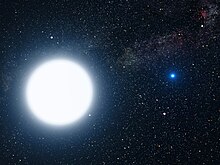
Back نجوم النسق الأساسي من النوع A Arabic Estrella blanca de la seqüència principal Catalan A-type main-sequence star English Estrella blanca de la secuencia principal Spanish A-tyypin pääsarjan tähti Finnish Étoile blanche de la séquence principale French Estrela branca da secuencia principal Galician Bintang deret utama tipe-A ID Stella di classe A V Italian A型主系列星 Japanese

A motako sekuentzia nagusiko izar edo Sekuentzia nagusiko izar zuri bat, (A V) sekuentzia nagusiko izar bat da (hidrogenoa erretzen duena), A espektro motakoa eta V argitasun motakoa. Izar hauek, hidrogeno xurgaketa lerro indartsuen bidez definitutako espektroak dituzte.[1][2] 1,4 eta 2,1 eguzki masa artean kokatzen dira (M☉) eta 7600 eta 10.000 K arteko azaleko tenperaturak dituzte.[3] Adibide distiratsu eta hurbilak Altair (A7 V), Sirio A (A1 V) eta Vega (A0 V) dira.[4] A motako izarrek ez dute konbekzio gunerik eta, beraz, ez da dinamo magnetikorik izatea espero. Ondorioz, izar haizerik ez dutenez, ez dute x izpiak igortzeko bitartekorik.[5]
2019ko uztailean, astronomoek a motako izar baten aurkikuntzaren berri eman zuten, S5-HVS1, 1.755 km/s-ko abiaduran bidaiatzen duena, orain arte detektatu den beste edozein izar baino azkarrago. Izarra Grus (edo Grulla) konstelazioan dago, zeru australean, eta Lurretik 29.000 argi urtera, eta Esne Bidetik kanporatua izan zitekeen Sagitario A* rekin interakzioan aritu ondoren, galaxiaren erdialdeko zulo beltz supermasiboa.[6][7][8][9][10]
- ↑ «Star Spectral Classification» hyperphysics.phy-astr.gsu.edu (Noiz kontsultatua: 2021-06-01).
- ↑ Carroll, Bradley W.. (2017). An introduction to modern astrophysics. (Second edition. argitaraldia) ISBN 978-1-108-42216-1. PMC 991641816. (Noiz kontsultatua: 2021-06-01).
- ↑ Habets, G. M. H. J.; Heintze, J. R. W.. (1981-11-01). «Empirical bolometric corrections for the main-sequence» Astronomy and Astrophysics Supplement Series 46: 193–237. ISSN 0365-0138. (Noiz kontsultatua: 2021-06-01).
- ↑ SIMBAD, entries on Sirius A and Vega, accessed June 19, 2007.
- ↑ (Ingelesez) Schröder, C.; Schmitt, J. H. M. M.. (2007-11). «X-ray emission from A-type stars» Astronomy and Astrophysics 475 (2): 677–684. doi:. ISSN 0004-6361. (Noiz kontsultatua: 2021-06-01).
- ↑ (Ingelesez) Overbye, Dennis. (2019-11-14). «A Black Hole Threw a Star Out of the Milky Way Galaxy» The New York Times ISSN 0362-4331. (Noiz kontsultatua: 2021-06-01).
- ↑ Koposov, Sergey E.; Boubert, Douglas; Li, Ting S.; Erkal, Denis; Da Costa, Gary S.; Zucker, Daniel B.; Ji, Alexander P.; Kuehn, Kyler et al.. (2020-01-11). «The Great Escape: Discovery of a nearby 1700 km/s star ejected from the Milky Way by Sgr A*» Monthly Notices of the Royal Astronomical Society 491 (2): 2465–2480. doi:. ISSN 0035-8711. (Noiz kontsultatua: 2021-06-01).
- ↑ (Ingelesez) Starr, Michelle. «Bizarre Star Found Hurtling Out of Our Galaxy Centre Is Fastest of Its Kind Ever Seen» ScienceAlert (Noiz kontsultatua: 2021-06-01).
- ↑ (Ingelesez) «Fastest star ever found is being flicked out of the Milky Way» New Atlas 2019-11-13 (Noiz kontsultatua: 2021-06-01).
- ↑ (Ingelesez) Plait, Phil. (2019-11-13). «Our local supermassive black hole shot a star right out of the galaxy» SYFY WIRE (Noiz kontsultatua: 2021-06-01).
© MMXXIII Rich X Search. We shall prevail. All rights reserved. Rich X Search